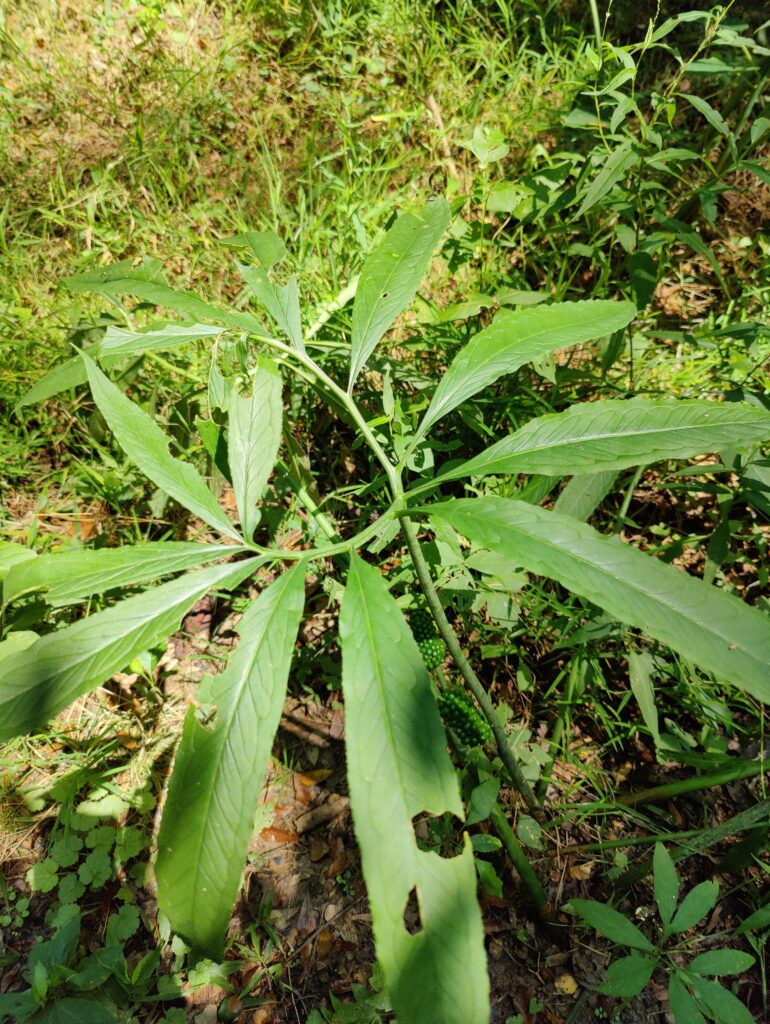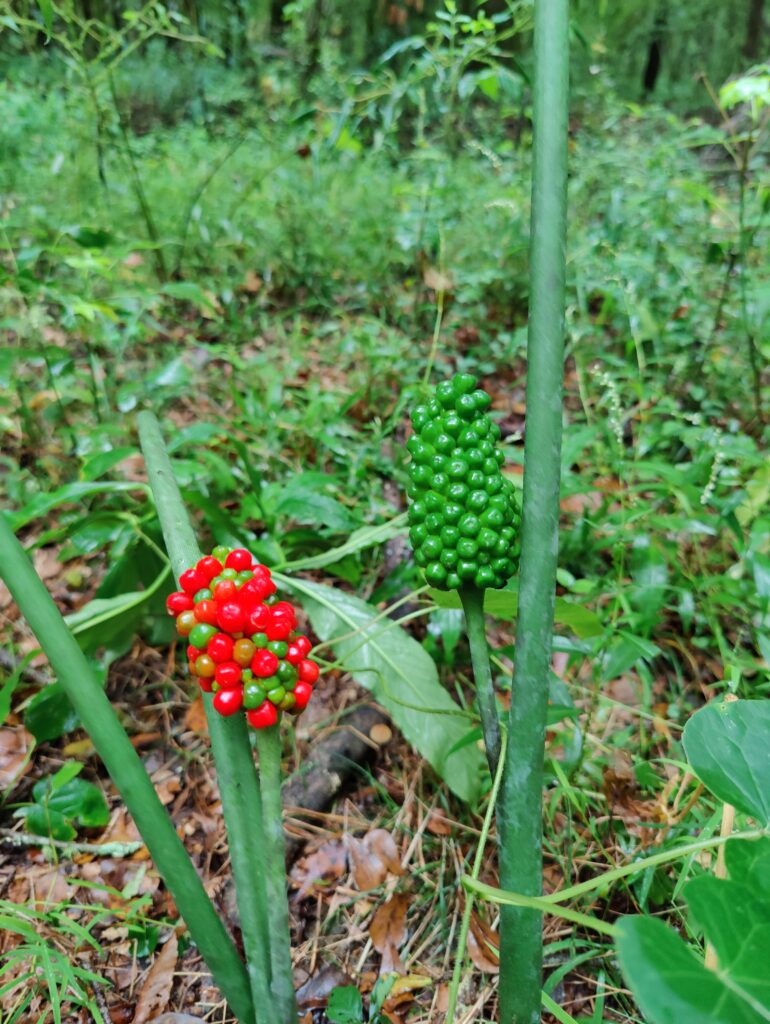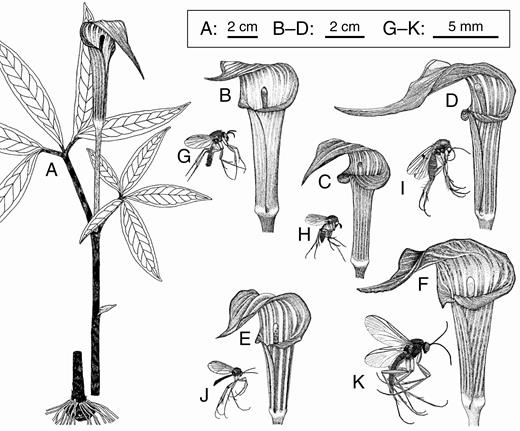
Part of the Georgia Piedmont Wild Ones Chapter’s mission is to shine a spotlight on Georgia’s unique and beautiful native plants. Today, we are going to dive into the natural history and ecology of Jack in the Pulpit, a very special plant that is reaching full bloom this time of year. Jack in the Pulpits (Arisaema sp.) are long lived (10+ years!) perennials native to Eastern North America, from the southernmost tip of Florida all the way up into Canada. Habitats include riverbanks, bottomlands, ravines, seeps, swamps, and many other moist, shaded areas. Reaching roughly two feet tall at maturity and flowering in late Spring, Jack in the Pulpit retreats underground during the hottest parts of the year after fruiting.
The name Jack in the Pulpit comes from the unusual shape of its flower, which resembles a preacher bowing their head (spadix) over a pulpit (spathe). Belonging to the Aurum family (Araceae), there are a handful of species of Arisaema found throughout the Southeast, including at least three subspecies of A. triphyllum. The species are distinguishable by leaf and flower morphology, and are maintained by their own specialist pollinators (we will touch more on pollination later). Some of the more common species in the Southeast are A. triphyllum var. triphyllum (Three-Leafed Jack), A. triphyllum var. quinatum (Five-Leafed Jack), and the closely related Arisaema dracontium (The Green Dragon), sporting 5-13 leaflets. Jack In The Pulpits may not be the showiest plant in the landscape, but what they lack in extravagance, they make up for in mystery and allure.

Jack in the Pulpits (also known as Indian Turnips) were a traditional staple of Native American peoples, who utilized the plants as a source of food, medicine, and more practical applications such as musical instruments and tools of war. All parts of Jack in The Pulpit contain highly toxic calcium oxalate crystals. This was recognized by Native Americans and they developed methods of processing the plant to denature the calcium oxalate crystals so the plant could be consumed. The most commonly used part of the plant was the underground corm, which was typically dry roasted for several days before being either ground into a “flour” or sliced up for different dishes. The taste and texture are said to resemble a cross between a potato and a turnip, with a slight hint of cacao. Alternatively, drying the corms for weeks in the open air produced a similar result. The seeds of the plants were dried and placed in gourds for use as rattles in ceremonial performances. These same drying processes were used to prepare the Jack In the Pulpits for medicinal uses, which included eye washes, snakebite treatments, cold relief, anti-diarrhea elixirs, and much more. Jack In the Pulpits were also employed on the offensive, with some tribes hiding pieces of raw corm in freshly killed game for enemies to find.

Not only have we discovered the usefulness of Jack in the Pulpits, but native wildlife as well, which are are seemingly unaffected by the calcium oxalate found in Jack in the Pulpits. In fact, a plethora of different species enjoy eating the plants: black bears and white-tailed deer forage for the corms in late Spring, while wild songbirds and turkeys consume the berries in Summer. We may never evolve the internal defenses needed to have a taste of fresh Jack in The Pulpit, but wildlife seems to have evolved to enjoy it.
Now, let’s discuss another intriguing aspect of these mysterious plants – their reproduction. Jack in the Pulpits are dioecious, meaning each plant produces either male flowers or female flowers, but not both in the same year. Male and female Jack in the Pulpits display a long, pitcher shaped tube (the spathe) with smooth walls and a column-like spadix consisting of multiple tiny flowers. Both sexes of flower are simple, with male flowers having four stamens and female flowers having a hairy stigma positioned on top of an ovary. Typically, younger plants produce male flowers, while mature plants produce female flowers; however, Jack in the Pulpits have the ability to switch the sex of their flowers each year. One of the main factors that determines the flower’s sex is the amount of carbohydrate stored in the corm – female flowers are much more energetically expensive to produce, which can take years to accumulate. Environmental stressors that weaken the plant, such as drought and disease, can also cause the plant to revert back to producing only male flowers.
Jack in the Pulpit flowers give off the aroma of decaying fungus, which attracts a specific pollinator: the fungus gnat (Sciaridae and Mycetophilidae). Fungus gnats are well known for being a common greenhouse pest, yet they perform important pollination services in nature. Fungus gnat larva feed on fungus, and will often move on to eating roots of nearby plants once those resources are exhausted, which can become troublesome for plant enthusiasts. Each species of Jack in the Pulpit is pollinated by a distinct species of fungus gnat – known as pollinator specificity – and it allows for a diverse array of Jacks to inhabit the same area without hybridizing. Though it is not fully understood exactly why different fungus gnats have such high fidelity for specific Jack in the Pulpit species, it is likely that geographic distribution, difference in flowering times, as well as varying aromas play a role

Source: https://doi.org/10.1093/aob/mcaa204
The aroma given off by Jack in the Pulpits tricks gnats into thinking that they are about to find a perfect place to lay eggs and raise larvae; however, Jack in the Pulpits obviously have other things in mind. Jack in the Pulpit flowers, by design, are an ingenious pollinator trap: fungus gnats are lured into the spathe in hopes of finding fungus to lay their eggs on. The flowers are located on the lower part of the spadix, which forces the fungus gnats to travel deeper into the trap. They are not the most intelligent, so once they enter the spathe, which is covered by a “hood”, they have an extremely hard time escaping, and cannot cling to the extremely smooth surface of the spathe`s walls. Once trapped, the fungus gnat will remain in close proximity to the flowers for as long as possible, bouncing off anthers and adorning the sticky pollen of the male flowers, or depositing pollen continuously on the stigmas of female flowers. Male flowers do offer a chance of escape, however, in the form of a pinhole in the very base of the spathe. This allows for the fungus gnat to exit freely, while covered in pollen, in the hopes that the gnat will be duped into another trap – a female flower. The female flowers offer no such escape, and the fungus gnats typically die after exhausting themselves. Once the female flowers are successfully pollinated, the ovaries will ripen into a cluster of red berries, which are then dispersed by wildlife or by water.
From a conservation standpoint, it is important to note that this miraculous interaction between fungus gnat and Jack in the Pulpit can occur because the environmental conditions are just right for both to co-exist. Both the fungus gnats and the Jacks are specialists in areas with high humidity, and any serious disturbances to our forest ecosystems can spell disaster for the diversity of both organisms. Logging, changes in hydrology, urban development, and climate change have a direct impact on fungus gnats and Jack in The Pulpits, which cannot thrive without each other. To protect these sensitive interactions, and carry on the rich cultural heritage of Jack in the Pulpits, we must keep these issues in mind.
We hope you have been inspired to experience the wonder of Jack in the Pulpits as they are in nature, and maybe even in your own backyard.
